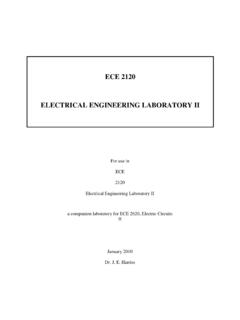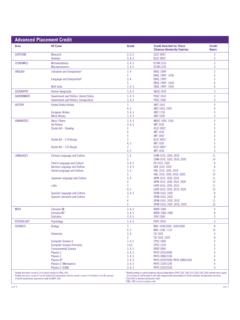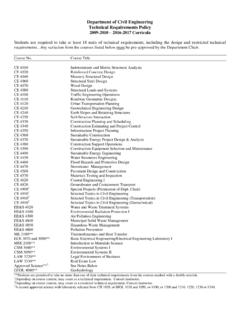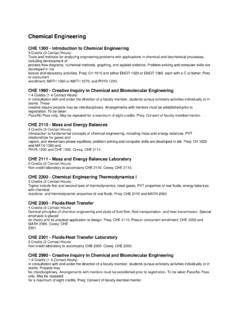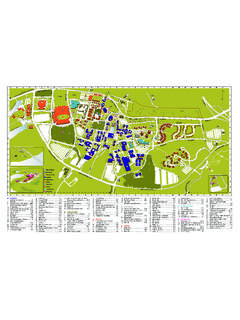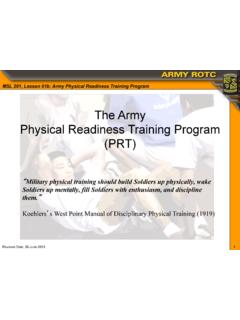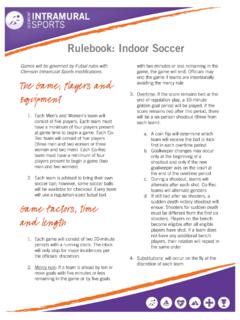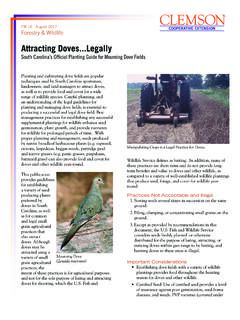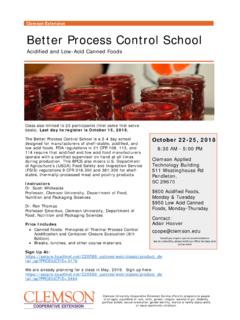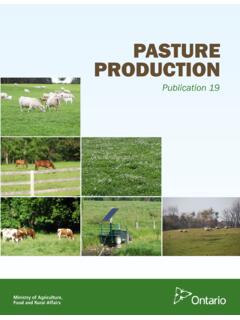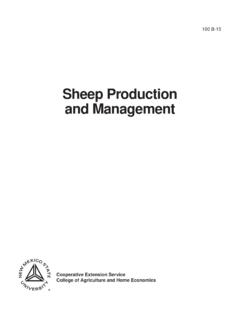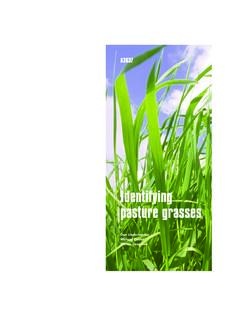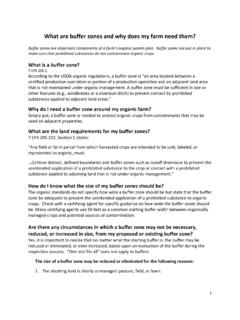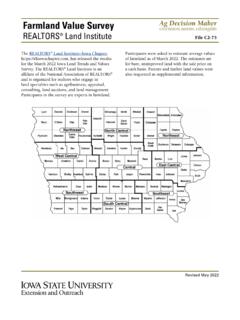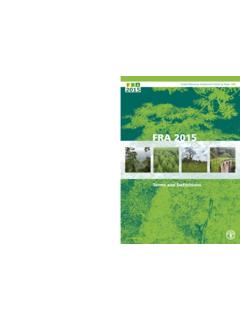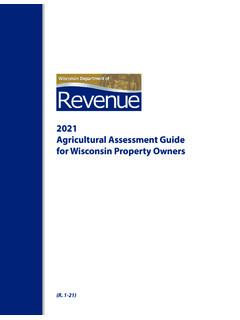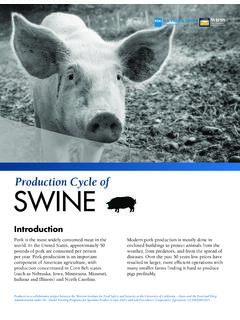Transcription of Dairy Manure Production and Nutrient Content
1 3a - 1 CHAPTER 3a Dairy Manure Production and Nutrient Content John P. Chastain, and James J. Camberato INTRODUCTION Knowledge of the amount of Manure and plant nutrients produced on a Dairy farm is the first step in the proper operation of a Manure handling and utilization system. The Nutrient Content of Dairy Manure will vary with the digestibility of the ration, animal age, amount of feed wasted, the amount of water wasted, the amount of bedding used, and the amount of water used to remove Manure from the buildings. The data provided in this chapter is to be used for general planning purposes. South Carolina regulations (Standards for the Permitting of Agricultural Animal Facilities: ) require Dairy producers to have Manure samples analyzed annually and to determine Manure volumes to establish land application rates. CALCULATION OF AVERAGE Production LIVE WEIGHT AND ANIMAL UNITS The South Carolina Standards for the Permitting of Agricultural Animal Facilities (R.)
2 61-43) uses the average animal live weight to determine the size of a Dairy farm. The average animal live weight is defined as: Average Animal Live Weight = (Entry Weight + Exit Weight) / 2. ( ) This definition applies to Dairy animals that are housed in a confinement facility or feedlot that requires the collection and utilization of Manure in a permitted Manure handling system. Dairy animals that are kept entirely on pasture, such as replacement heifers, are not included in the calculation of the average Production live weight. In most cases, the average Production live weight on a Dairy farm is simply the average weight of the cows that can be obtained from farm records. The normal Production animal live weight is calculated as: Normal Production Animal Live Weight = Average Animal Live Weight x Number of Animals in Confinement. ( ) Dairy operations with more than 500,000 pounds of total normal Production animal live weight fall under the regulations for large facilities.
3 3a - 2 Example What is the normal Production animal live weight for a Dairy farm that houses 300 Holstein cows in a freestall barn if the average 1st lactation heifer weighs 1,200 lb and the average cow that exits the herd weighs 1,500 lb? Step 1: Average Animal Live Weight = (1,200 + 1,500) / 2 = 1,350 lb / cow Step 2. Normal Production Animal Live Weight in the barn = 1,350 lb / cow x 300 cows = 405,000 lb. Example A Dairy producer has a freestall barn that houses a milking herd of 400 Jersey cows. The milking herd records indicate that the average cow weight is 880 lb. Calculate the total normal Production animal live weight in confinement on this farm. Normal Production Animal Live Weight = 880 lb/cow x 400 = 352,000 lb. Another definition that is used in Manure management calculations is the animal unit. In this manual, an animal unit (AU) is equal to 1,000 lb of normal Production animal live weight. The total number of animal units on a farm is: Total Number of Animal Units = Normal Production Animal Live Weight / 1,000.
4 ( ) Example Calculate the total number of animal units for a Dairy farm with a normal average Production animal live weight of 405,000 lb. Total AU = 405,000 lb 1,000 lb/AU = 405 AU. Manure Production Dairy animals produce about ft3 ( gal) of fresh Manure (feces and urine) per 1,000 lb average live weight per day. The Manure contains lb of total solids per AU per day. The volatile solids Production is lb per AU per day. The actual volume of Manure that must be handled on a Dairy is typically more than ft3/AU-day. Additional solids can be added from wasted feed, freestall bedding, and soil tracked in from outside lots. Additional water is often added from waterer wastage, milking center waste water, water used to clean floors, and flushing of alleys. The variation of Manure Production for Dairy facilities will vary with the solids Content (TS) as shown in Table 3a - 3 Table Variation of Dairy Manure Production (ft3 / AU - day) depending on consistency of removed Manure .
5 Total Solids Content (TS) Manure Removed As: 1% 2% 4% 6% 8% 10% 12% 14% Thick Slurry minimal water a b Slurry + Milking Center Waste Slurry + Parlor Flush Alley Flush All Facilities Flushed Milking Center Only C TS ft3/AU-day Twice-a-day (2X) milking Milking 3 times per day (3X) 2X milking with flush 3X milking with flush Manure and Sand Bedding 20 to 38% d a Volume (ft3 /AU/day) = lb TS/AU-day x TS (%). To convert to multiply ft3/AU-day by b Typical volume and TS indicated in bold.
6 C Volume (ft3 /AU/day) = ( lb TS/AU- milking x No. Milkings/day x ) TS (%) d Varies with sand usage per freestall. References: Stowell and Bickert (1995) and Fulhage (2003) Example A Dairy producer has a freestall barn that houses 300 Holsteins. Manure is scraped with a skid-steer loader into a reception pit near the center of the barn. All of the wash water and waste from the milking center is also collected in the reception pit with the Manure . How much Manure will be generated each day? What volume of Manure will be generated in 1 year? Step 1. Assuming that the average cow weights 1,350 lb, the total number of animal units in the barn is: 300 x 1,350 1,000 lb/AU = 405 AU. Step 2. Assuming that the total solids Content of the Manure is 8%, ft3 of Manure is produced per AU per day (Table ). The volume of Manure that must be handled each day is: ft3/AU-day x 405 AU = 1, ft3/day or 8,725 gal/day. Step 3.
7 The total Manure volume that will be produced in 1 year is: 1, ft3/day x 365 days/year = 425,736 ft3/year or 3,184,505 gal/year. Example A Dairy producer grazes 120 Jersey cows intensively and the only facility that requires collection and storage of Manure is the milking center. The cows are milked twice each day and a high-pressure hose is used to clean the parlor and holding area floors. Estimate the volume of milking center waste that must be collected and stored each day. From Table , ft3 of milking center waste is generated per AU per day. The number of animal units in the milking herd is 108 (900 lb/cow x 120 / 1,000). The daily volume of milking center waste is 3a - 4 108 AU x ft3/AU-day = ft3/day or gal/day. Example Sand bedding is used in a 4-row drive through freestall barn that contains 100 stalls. Typically 110 Holsteins are housed in the barn. The Dairy producer plans on building a concrete Manure storage to contain 90 days of sand-laden Manure .
8 Milking center waste will not be included. What is the required Manure storage capacity? Step 1. Assuming that the average cow weights 1,350 lb, the total number of animal units in the barn is: 110 x 1,350 1,000 lb/AU = 149 AU. Step 2. Allow ft3/AU-day for sand-laden Manure as shown in Table The required sand-laden Manure storage capacity is: 149 AU x ft3/AU-day x 90 days = 21,456 ft3or 160,491 gal. Nutrient Content OF Dairy Manure Dairy Manure contains all 13 of the essential plant nutrients that are used by plants. These include nitrogen (N), phosphorous (P), potassium (K), calcium (Ca), magnesium (Mg), sulfur (S), manganese (Mn), copper (Cu), zinc (Zn), chlorine (Cl), boron (B), iron (Fe), and molybdenum (Mo). Plant nutrients originate from the feed, supplements, medications, and water consumed by the animals. Using Dairy Manure as a fertilizer for crops or trees may provide a portion, or all, of the plant requirements. The amount of nutrients provided depends on the Nutrient Content of the Manure (lb of Nutrient / ton or lb of Nutrient / 1,000 gal) and the amount of Manure applied (ton / acre or gal/acre).
9 The amount of Manure applied per acre is called the application rate and is typically based on the nitrogen needs of the plants. However, phosphorous requirement can also be used to determine the application rate (for more details see Chapter 5, Waste Utilization). South Carolina regulations can also limit the land application rate of Dairy Manure based on the copper or zinc Content of the Manure . The Nutrient Content of Dairy Manure from several types of Dairy facilities is compared in Tables and The Nutrient values in these tables can be used for general planning before a new Dairy farm is constructed or prior to the expansion of an existing farm. In the case of an existing Dairy farm, sample analysis from the Dairy Manure on a particular farm should be used to perform Nutrient balances for land application. These values were compiled from a database that combines data taken on South Carolina Dairy farms with mean values from North Carolina State (Barker, 1990).
10 3a - 5 Table Comparison of the Nutrient Content of solid and semi-solid Dairy Manure . Nutrient data complied from Barker (1990) and data compiled from South Carolina farms. Manure Type Fresh Manure Scraped Paved Outside Lot Solids From Settling Basin Solids From a Stationary Screen Moisture 86% 67% 89% 80% Total Solids 14% 33% 11% 20% --------------------------------- lb / ton----------------------------------- NH4-N NO3-N --- --- Organic - N Total - N 1 P2O5 2

